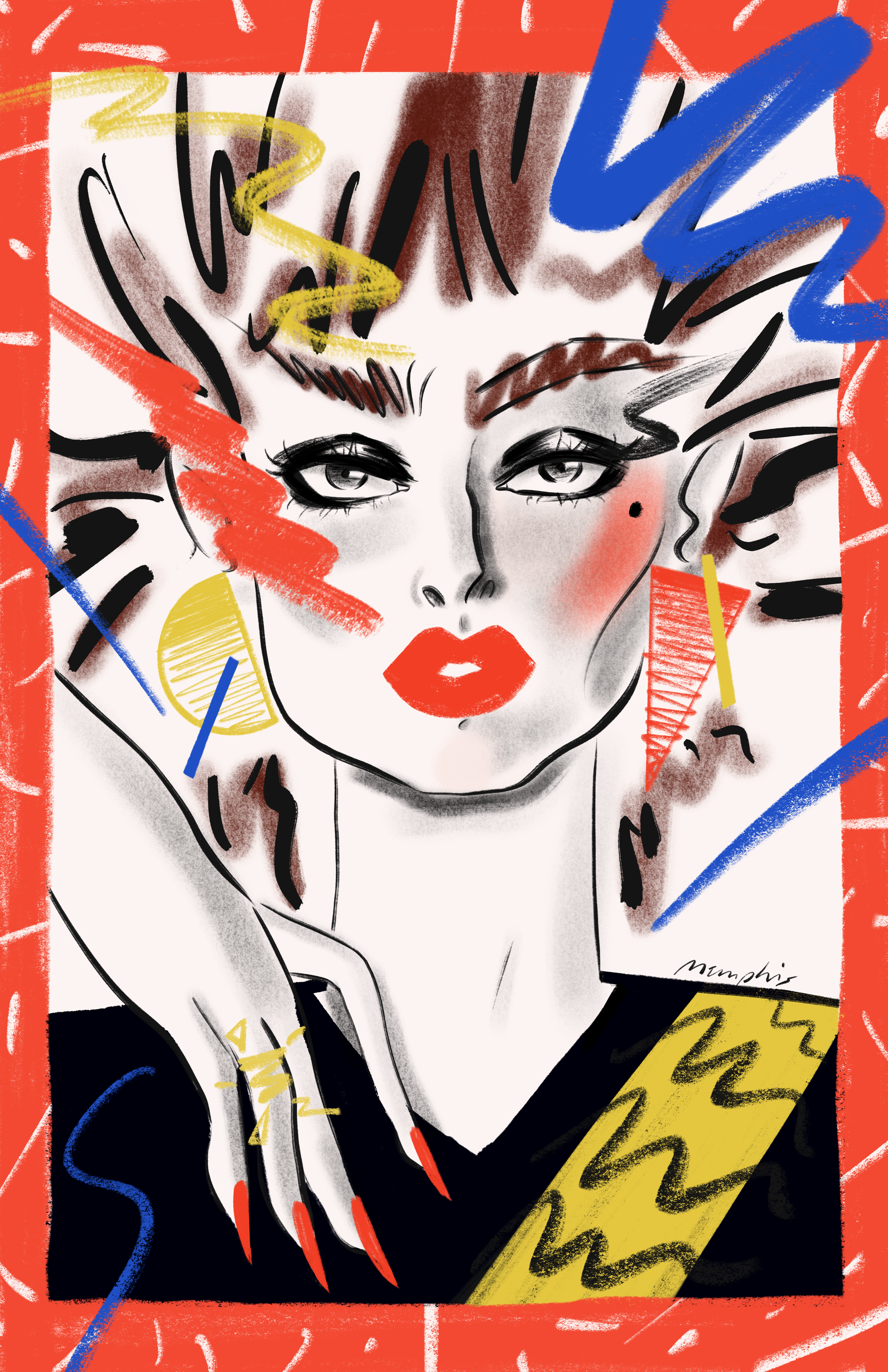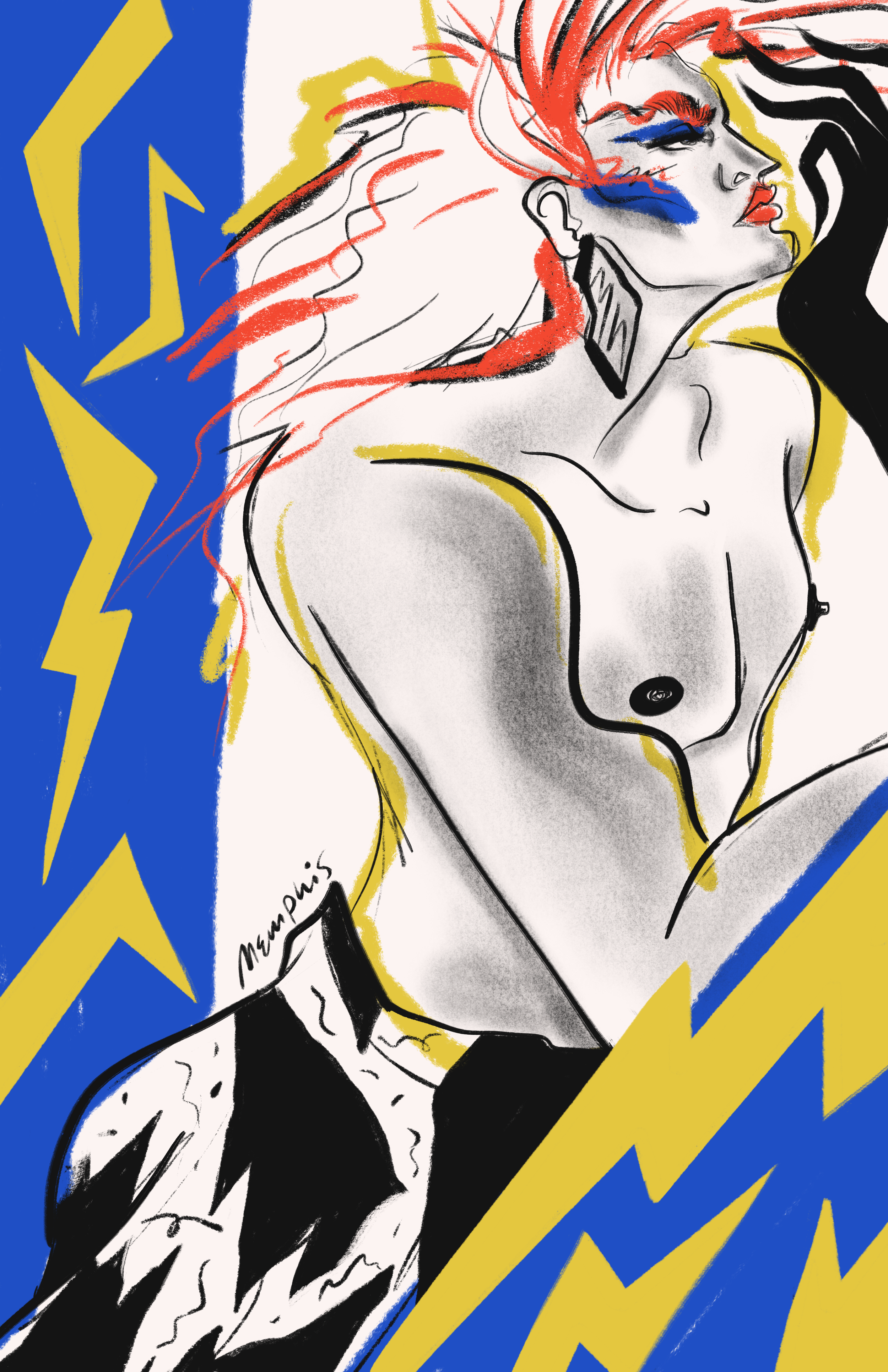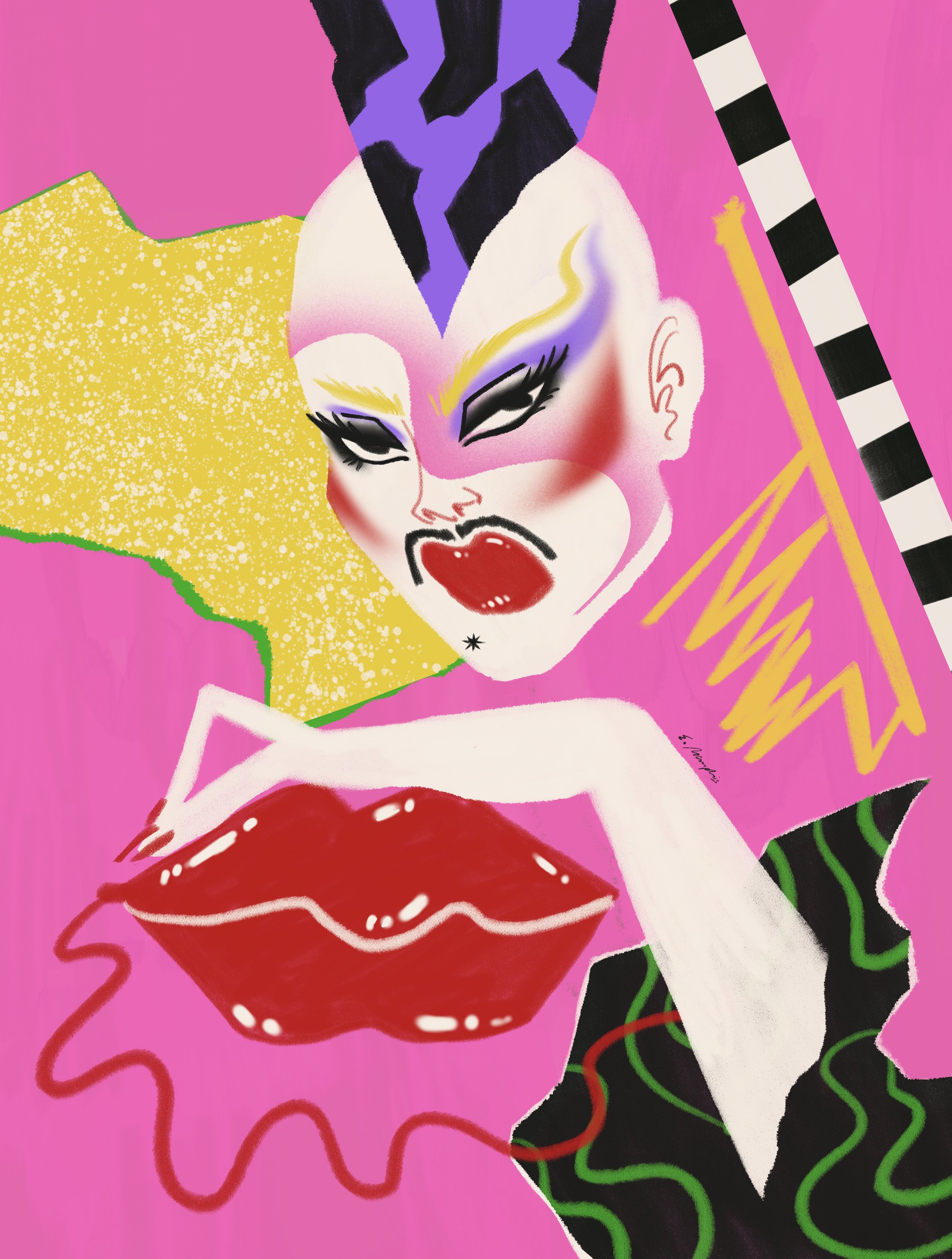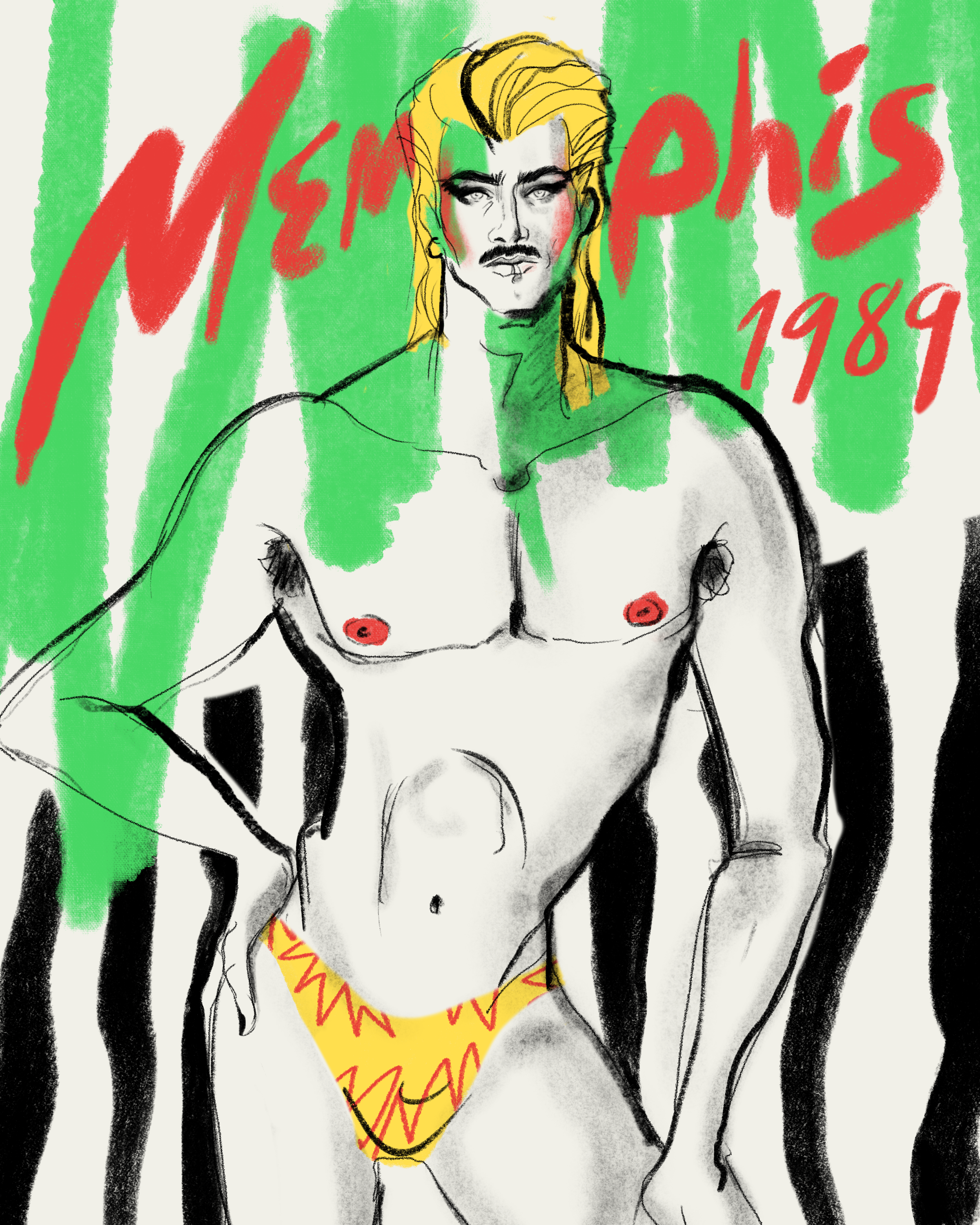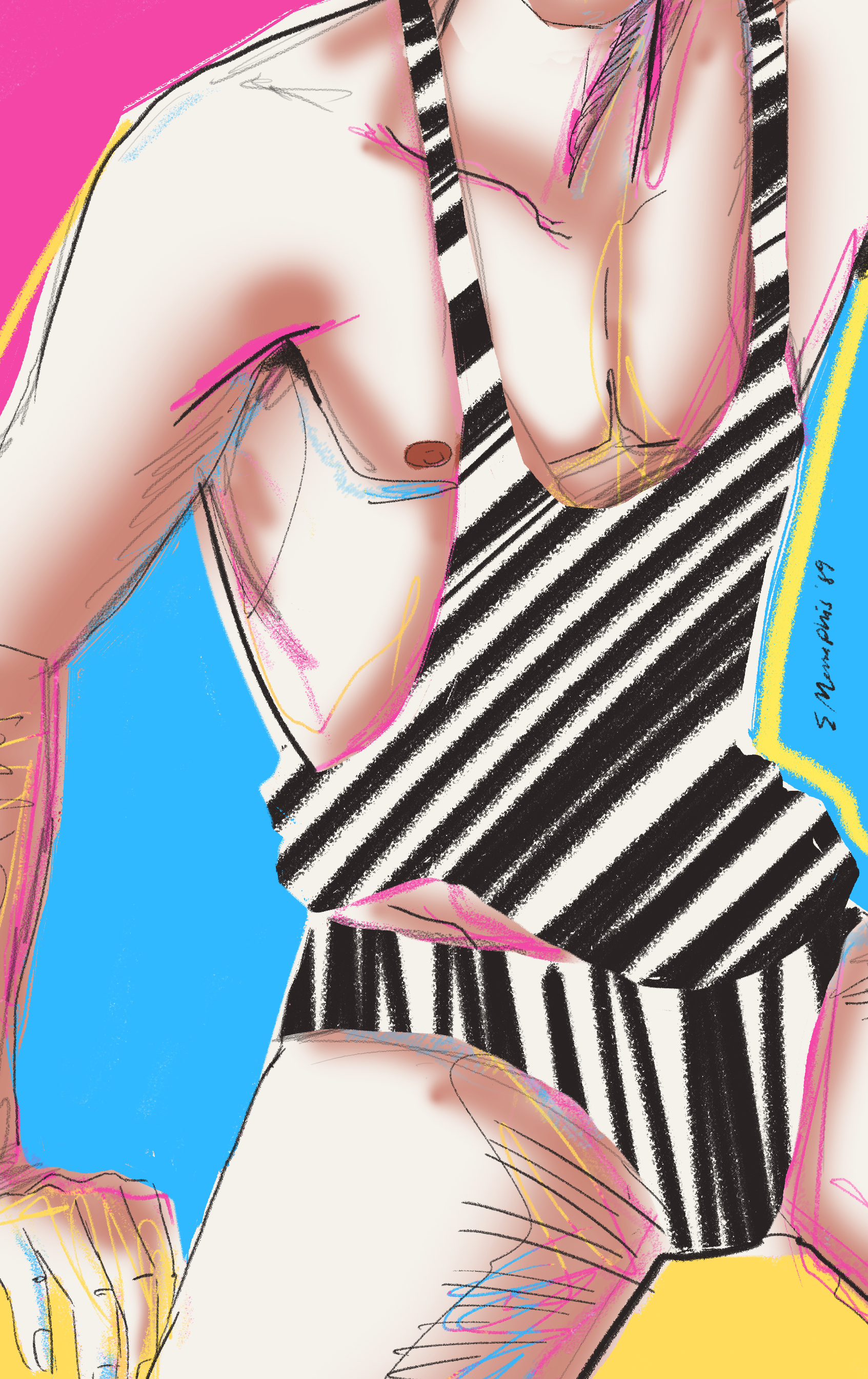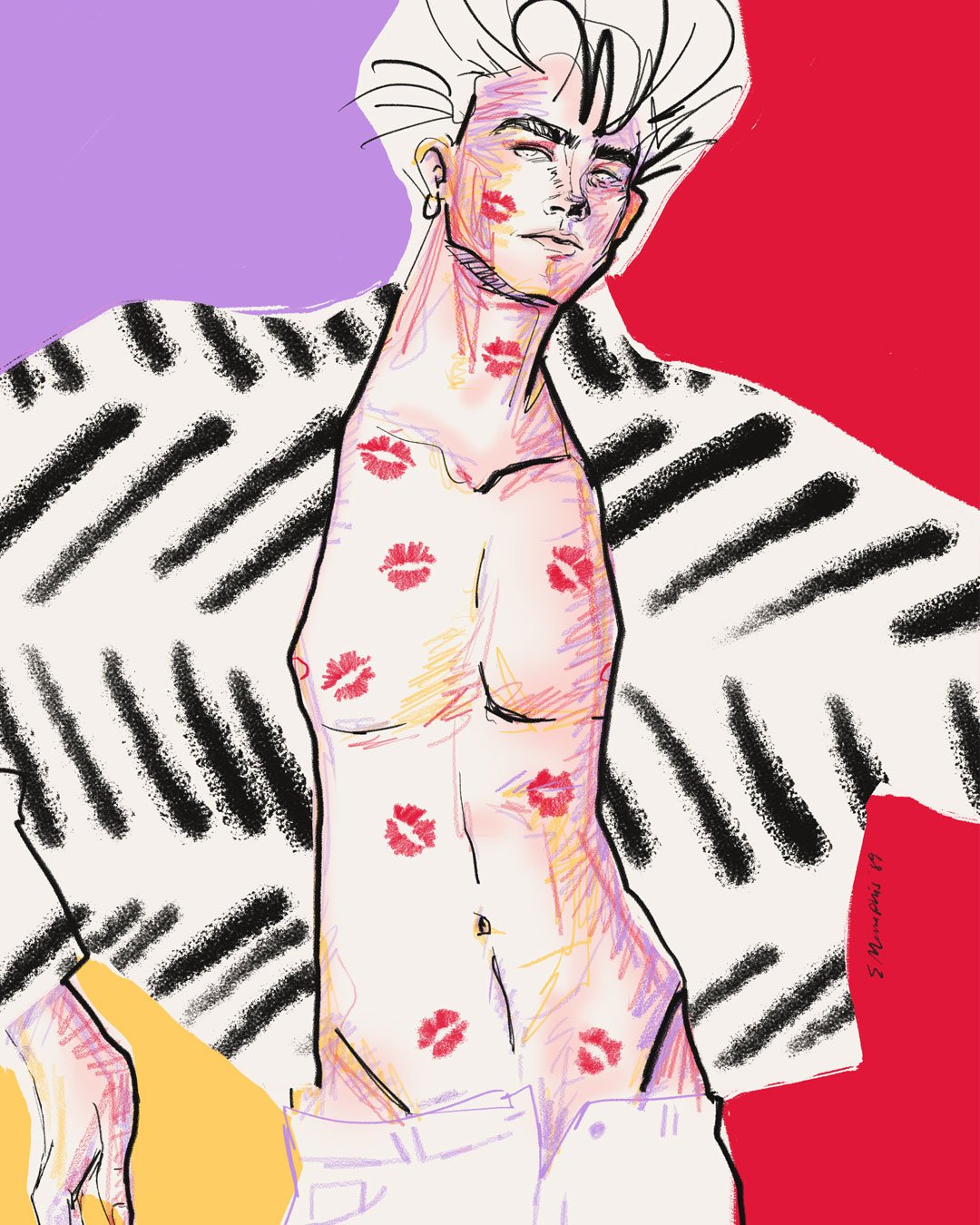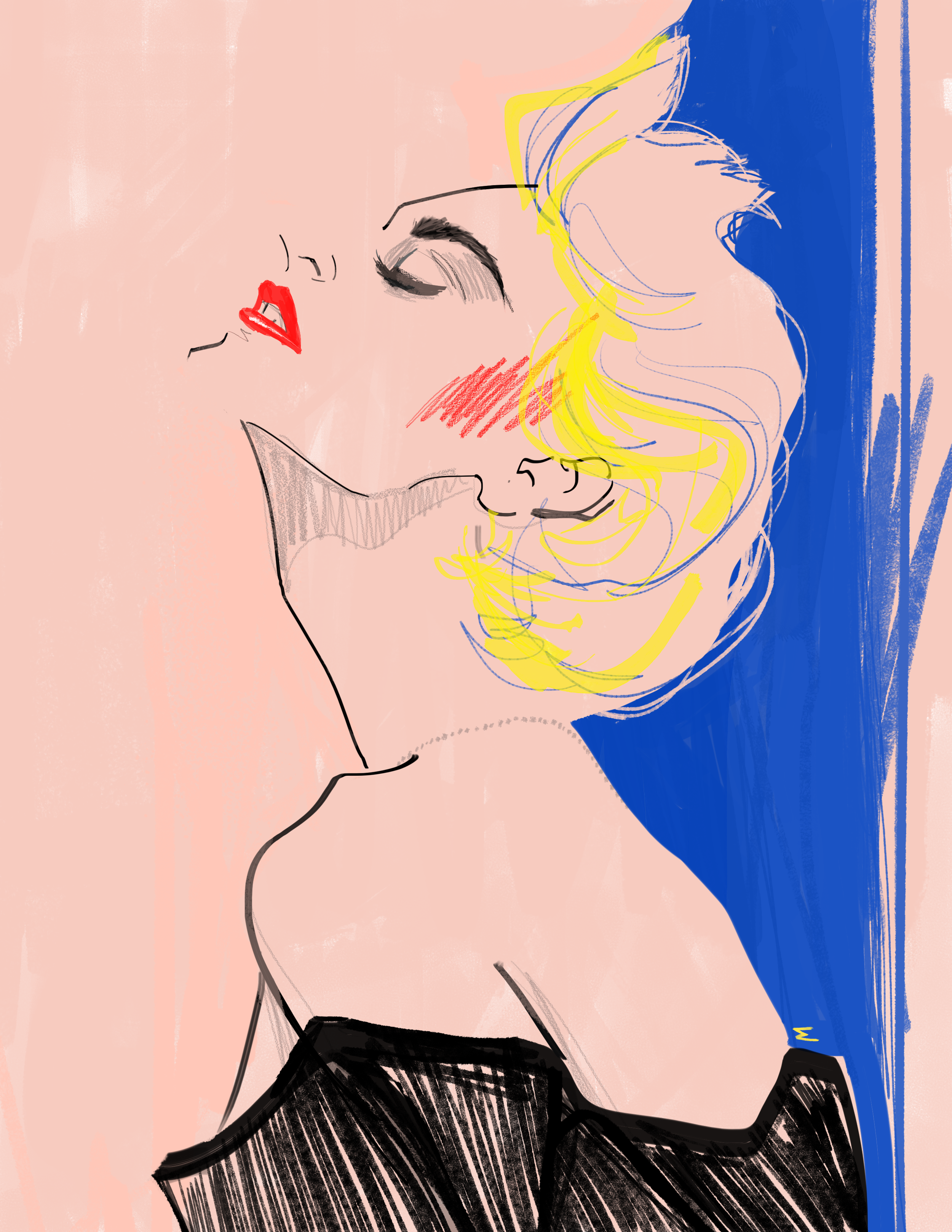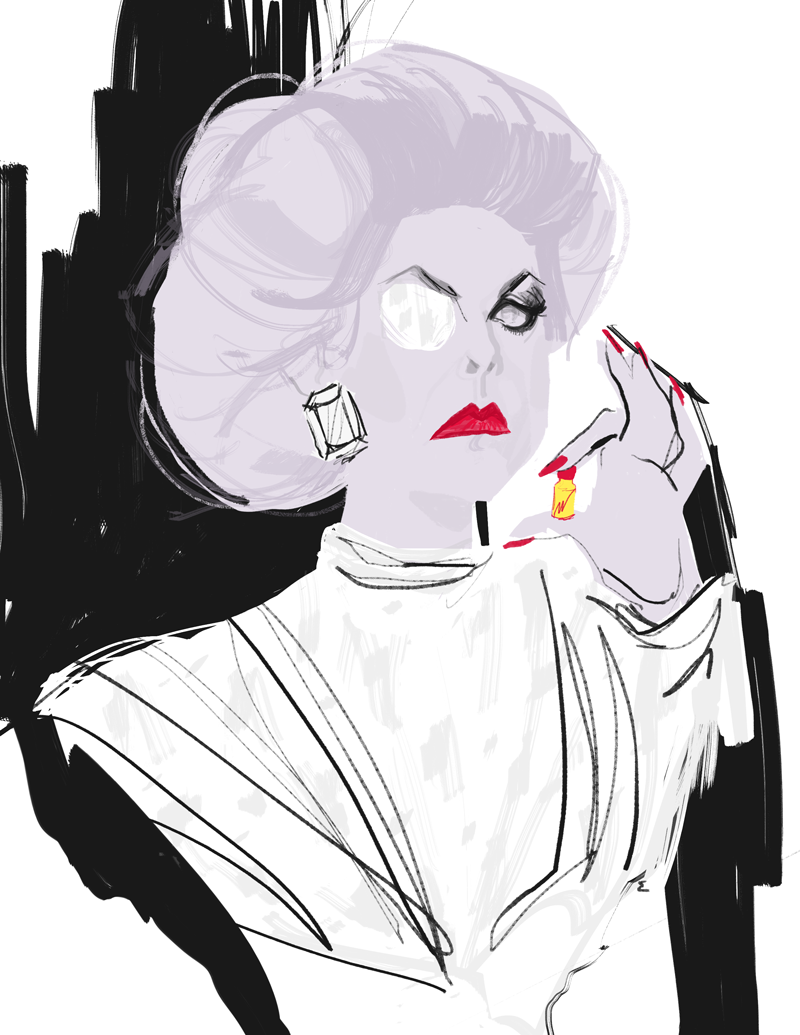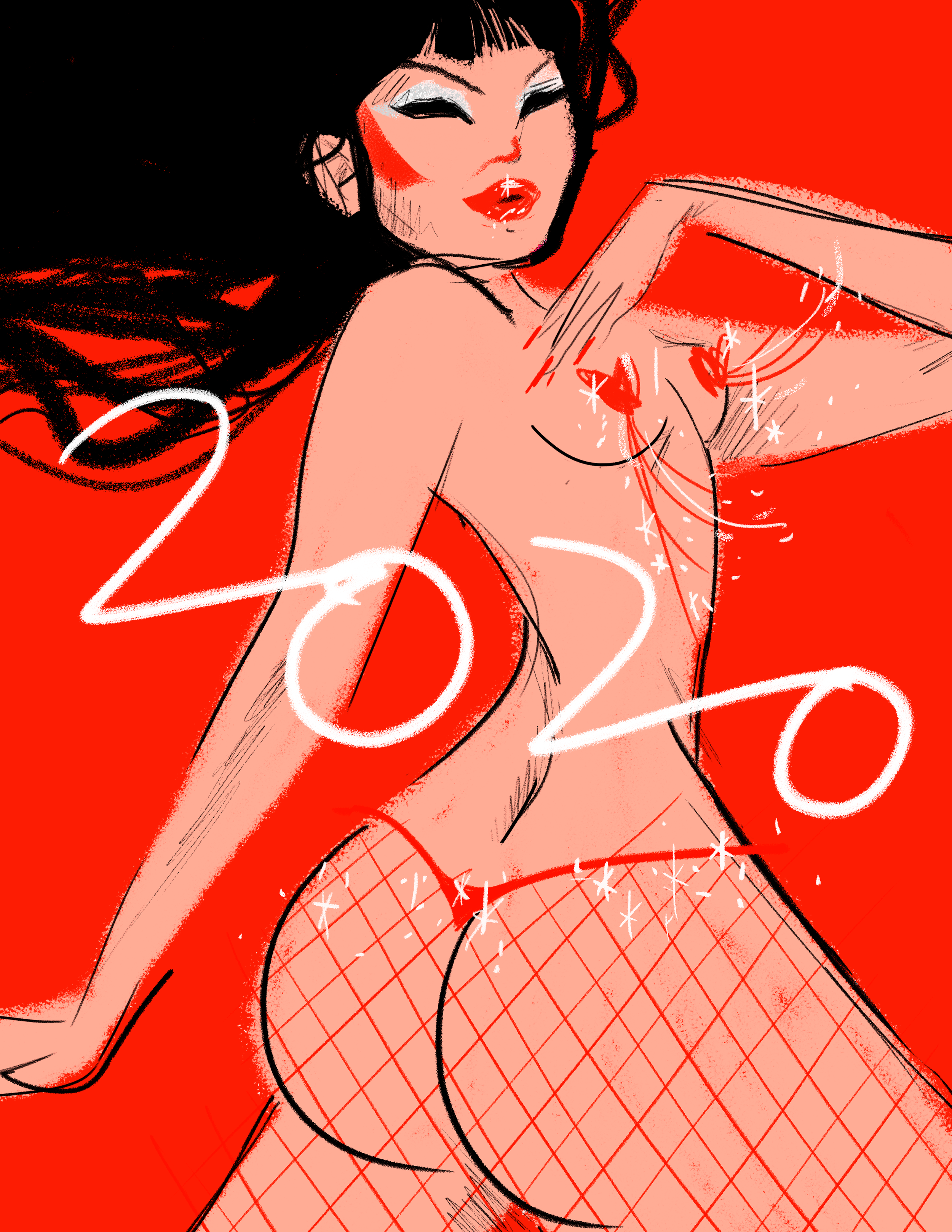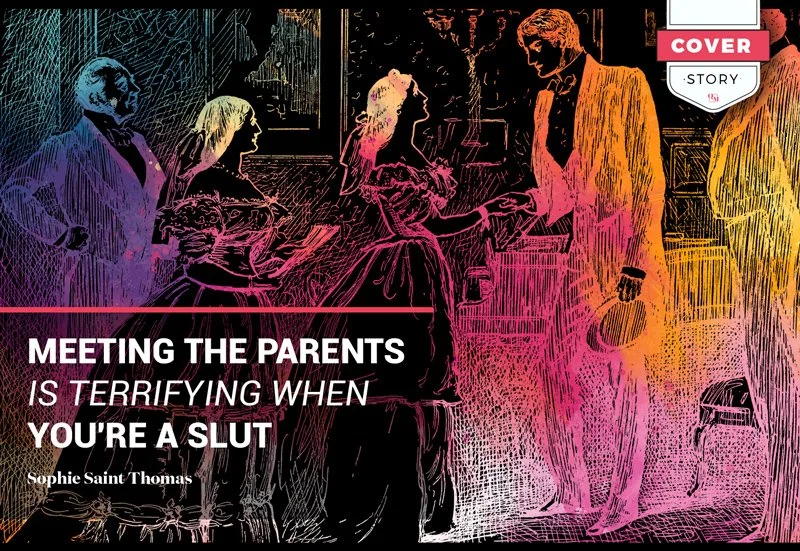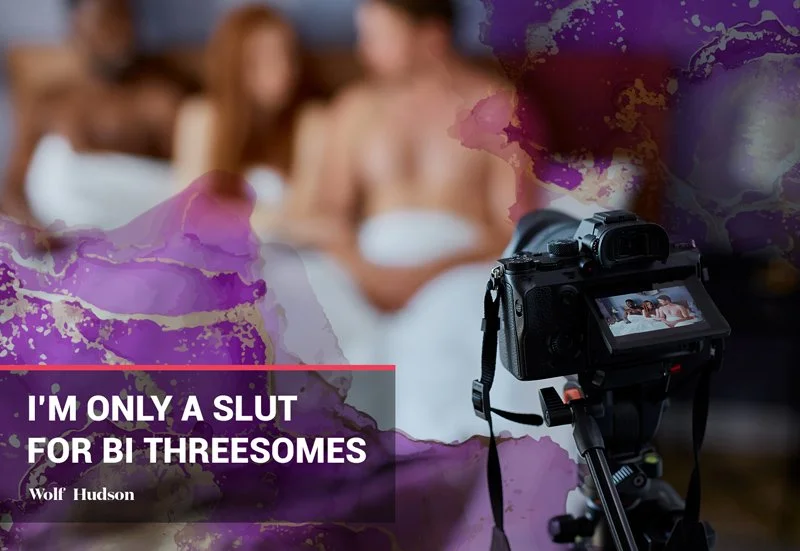Artist Feature: The Neovintage Glam of Eduardo Memphis
“I’m writing about sluts, and I’d like to interview you,” is perhaps one of the stranger ways I’ve opened a conversation. Luckily, illustrator and pop culture aficionado Eduardo Memphis was receptive. We spoke about sluts, telenovelas, Mexico City, music, and the internet-enabled revival of vintage glam.
QUEER MAXIMALISM
Eduardo is a self-described purveyor of “queer maximalism”, and even a cursory glance at his portfolio (though it deserves a much longer treatment) would attest to that descriptor. In his portraiture, the eye is instantly drawn to the huge lashes, lips, hair, earrings, and breasts of vintage starlets and modern drag queens alike. Bright blocks of complementary colors — sometimes defined by or contrasted with stark outlines to embolden a facial feature or make a flick of the nails pop — are as demanding, defiant, and electric as the 70s and 80s that inspired Eduardo’s style.
I asked about the drive and motivation behind this choice. Specifically, I wanted to know if there was a particular element of joy, freedom, or queer liberation about the era to which Eduardo was paying homage. The short answer? Yes and no. Though his aesthetic is reminiscent of the album covers and playful gender roles of the period, his subject matter itself isn’t confined to any specific era — rather, he brings that maximalism forward into a new, modern context.
“The characters I draw … are very muscular fellows with make-up and big hair,” he says. “My work is influenced by the maximalism of those decades, which of course I loved — when I look at 80s stuff, there’s lots of queerness, and nobody questioning it. Look at Boy George, Freddie Mercury, David Bowie…”
We also discussed the relative cultural and social license musicians were granted with gender expression — at least on the stage. “While in America society was still fairly closed-minded, in the UK it was more open-minded — it was a more creative time, and people experimented with lots of things. The music was sensational: synthpop, new wave…” There are heavy elements of drag and burlesque in Eduardo’s work — a celebration of femme or femme-like forms that showcase their aesthetic beauty without lusting after it through an objectifying or reductive lens.
And if the 70s and 80s vibe seems like a call-back, it’s a timely one, considering the rise in popularity that drag and burlesque have recently experienced in mainstream culture. Eduardo points out, “When I look at the work of illustrators and make-up artists from that decade, they had to do everything from scratch.” Today, by contrast, we have Pinterest, YouTube, TikTok, and endless resources for those wanting to learn a cut-crease, the perfect smokey eye, or winged eyeliner. What was once the province of select performers protected by their alter-egos or stage personas is now more widely accepted.
SLUTS
The motif of this issue of Queer Majority is unashamed sensuality and sexuality, and as such I asked Eduardo how these themes manifest in his work. While Eduardo’s illustrations are bold and fierce, the artist himself is more reserved:
“I don’t consider myself sexy, or much of a vessel of sexuality. There was a time in my life when I wondered if I was bisexual — I wasn’t — and I think the purpose of my art is to express that sexy side and sensual spirit that I don’t personally have. If you look at Bettie Page, for example, a lot of those pictures were quite hot for their time and featured things that are more accepted today, but we as people have always been attracted to these pin-ups and beefcake shots — and why wouldn’t we be? They are, precisely, works of art, featuring bodies that are beautifully sculpted.
The past few decades have treated this kind of playful eroticism paradoxically, both deriding and upholding it. Discussing these underlying messages, particularly when it comes to women’s sexuality or queer sexuality, which have historically been depicted as less valid and/or more “deviant” than straight male desire, we spoke about the prevalence of slut-shaming in popular culture.
Eduardo mentioned how, in the show The Golden Girls, Blanche’s blunt libido and escapades were often framed as the butt of the joke — we noticed a similar treatment of Samantha’s character in the original run of Sex and The City. Eduardo was no stranger to condemnations of this sort, growing up in a Catholic country under the watchful eye of telenovelas (Latin American soap operas). Specifically, he remembers watching Santa, a good-girl-gone-bad story in which the archetypal fallen woman loses her beloved, her home, and her wealth for the crime of having sex.
“That was a recurring theme in the 40s and 50s in Mexican cinema. When Hollywood shut down production, a lot of movies came to Mexico City, and throughout the 60s and 70s, there was a revolution over here. It’s not so extreme now; today, they (the telenovelas and films) are usually about a poor girl who falls in love with a rich guy.” Eduardo’s work is both a conscious rejection of this naysaying and an outlet for his more sensual side.
MEXICO CITY AND MUSIC
Mexico City itself, where Eduardo lives, has been an undeniable influence on his work. For example, his 2017 piece, Tale of a Magician, was inspired by the Mexico City subway system.
He attended the Tecnológico de Monterrey and graduated with a Bachelor's in Animation and Digital Arts. I asked about that education and the effect it’s had on his artistic career.
“I’ve always been drawing, for as long as I can remember — I think I was born with a pencil, doodling my way into my mum's diary. But I never took it seriously, because here, art and culture are not very well paid, so before and during college, I used it as a tool. When the time came to graduate, I thought, ‘I really need to do something’, and my only talent was drawing … So I drew on my PC, learned to use Photoshop, and applied for a job as an illustrator.
“On the side, I’ve had my Instagram. In 2012, it was a different world. My style wasn’t popular then, but I’ve always followed my instinct … even if it wasn’t fashionable at the time. People didn’t understand [my work], but I just kept on. I was very frustrated, especially considering other illustrators got work doing ‘safe,’ cutesy pictures of cats and dogs. But this meant keeping up a strong online presence, and they eventually stopped because they couldn’t keep up with being an influencer. I didn’t have that difficulty because I didn’t have that pressure to begin with.”
“I’ve done some freelance illustration, and that keeps me sane outside of my day job. I did some illustrations for a publishing house in Canada, and recently I started doing some textiles with my friend — I’m very interested in textiles. There’s a catalog of Spanish-speaking illustrators, of which I’m a part. Basically, if it’s something that will give me some exposure or creative freedom, I’m interested.
“There’s a band from Brooklyn called Good Judy, and another is Come On Everybody; I do posters for them. I’ve also worked on some illustrated branding for local musicians. The first one is called Male Tears, and for them I did some artwork, two covers, and one merch design. Another one is FM Attack, which is also 80s-inspired. My work has always been influenced by music, and my captions usually consist of the song that I’m listening to at the time.”
LEADING LADIES
In 2017, Eduardo was invited to do a series of illustrations featuring seven leading ladies of the Teatro del Bicentenario’s seventh anniversary season in Leon, Guanajuato, Mexico.
“[T]hey built this huge theater with great acoustics for the 200th anniversary of independence. I had a friend in Leon who recommended me for their seventh-anniversary celebrations. They provided pictures of the costumes and references, and bringing them to life in my paintings was a mix of reality and imagination. They needed consistency, so I went quite dark. The pictures are not as saturated as my previous work. I got invited to see that show, and it was amazing and surreal to see the costumes in the lobby, alongside postcards and banners of my artwork. If I had to choose a favorite, I’d pick the Madama Butterfly, because of her fan and her powerful outfit, but it’s hard to choose. Maybe Lucia, because of her strong bearing — her face and expression.”
DISNEY
Eduardo is also a Senior Product Development Designer at Disney, though his quiet personality and the nature of the work combine to make him fairly tight-lipped about it. “It’s a different side of me. I can’t talk about it much, and I try to not mix worlds, even though they ask me to. There are elements of my personal work that they do know about and like, but I’m like, ‘No, my freelance work is different.’ I love the characters and movies, but they aren’t mine.”
PLANS FOR THE FUTURE
2022 marks ten years as an artist and illustrator for Eduardo. Looking back, I asked how he feels about his achievements over that time, and what his plans for the future are:
“I’m proud that I’ve been able to work as an illustrator, and I plan to keep on doing that. This year is all about myself. I’ve got to the point where I have a special style, but I think it’s time to ramp it up and continue to build my profile. I’d like to send my portfolio anywhere and everywhere around the world and do more projects for myself locally. Whenever we get to the point where COVID-19 restrictions allow it, I’d like to go to illustration fairs in Mexico. I’ve reached a place where I need my art to be more silly. I want to believe I could do something indulgent and joyful.”
After several years of a pandemic and political turmoil, it’s not surprising that Eduardo’s work combats stagnation — on a physical, emotional, and sensual level. “I look at my portraits, and I’d like the subjects to enjoy more of a sense of storytelling. These characters are pretty, but I want to give them action, something to do, something compelling.”
And what could be more compelling than the unbridled and unapologetic exhilaration of being a slut — regardless of gender, sexuality, and era?
For more about Eduardo, follow him on Twitter.
Published Apr 19, 2022
Updated Sep 2, 2024
Published in Issue XI: Slut


